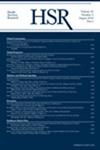Variation in batch ordering of imaging tests in the emergency department and the impact on care delivery
Abstract
Objectives
To examine heterogeneity in physician batch ordering practices and measure the associations between a physician's tendency to batch order imaging tests on patient outcomes and resource utilization.
Study Setting and Design
In this retrospective study, we used comprehensive EMR data from patients who visited the Mayo Clinic of Arizona Emergency Department (ED) between October 6, 2018 and December 31, 2019. Primary outcomes are patient length of stay (LOS) in the ED, number of diagnostic imaging tests ordered during a patient encounter, and patients' return with admission to the ED within 72 h. The association between outcomes and physician batch tendency was measured using a multivariable linear regression controlling for various covariates.
Data Sources and Analytic Sample
The Mayo Clinic of Arizona Emergency Department recorded approximately 50,836 visits, all randomly assigned to physicians during the study period. After excluding rare complaints, we were left with an analytical sample of 43,299 patient encounters.
Principal Findings
Findings show that having a physician with a batch tendency 1 standard deviation (SD) greater than the average physician was associated with a 4.5% increase in ED LOS (p < 0.001). It was also associated with a 14.8% (0.2 percentage points) decrease in the probability of a 72-h return with admission (p < 0.001), implying that batching may lead to more comprehensive evaluations, reducing the need for short-term revisits. A batch tendency 1SD greater than that of the average physician was also associated with an additional 8 imaging tests ordered per 100 patient encounters (p < 0.001), suggesting that batch ordering may be leading to tests that would not have been otherwise ordered had the physician waited for the results from one test before placing their next order.
Conclusions
This study highlights the considerable impact of physicians' diagnostic test ordering strategies on ED efficiency and patient care. The results also highlight the need to develop guidelines to optimize ED test ordering practices.

 求助内容:
求助内容: 应助结果提醒方式:
应助结果提醒方式:


